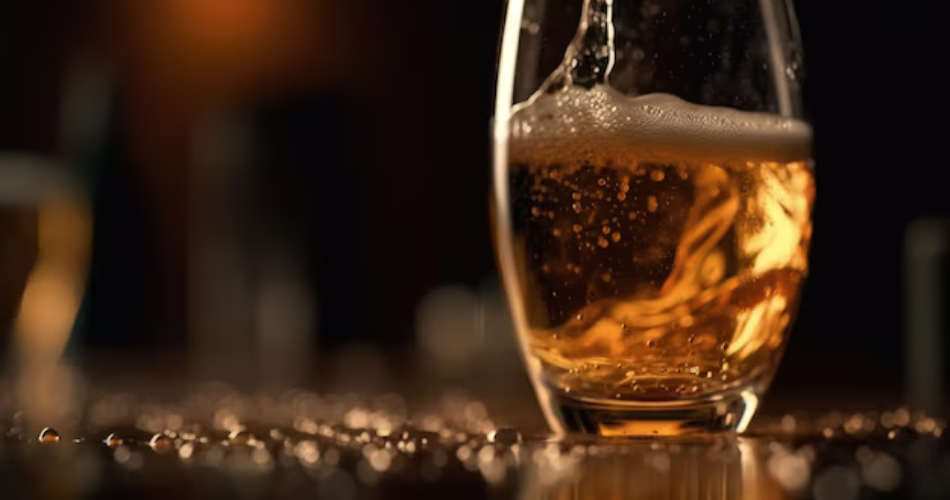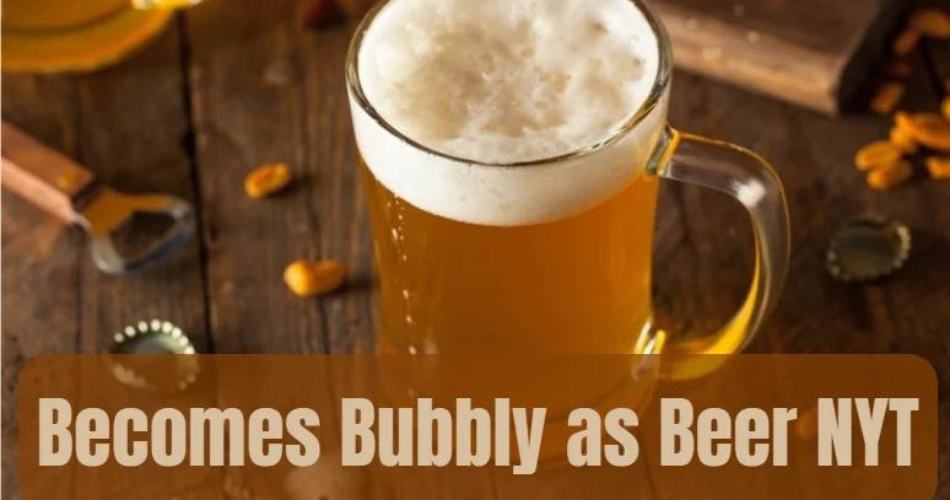To truly appreciate the allure of a freshly poured beer, you need to understand the magic behind its bubbles—the golden or amber liquid, the rising effervescence, and the foamy head that adds so much to the drinking experience. These bubbles aren’t just for show; they play a crucial role in defining a beer’s flavor, texture, and overall enjoyment. But what exactly causes beer to bubble when poured?
The answer lies in the science of carbonation and the behavior of carbon dioxide (CO2), which are key elements in creating beer’s signature fizz and foam. The amount, size, and persistence of these bubbles are influenced by a variety of factors, from the brewing process to the way the beer is poured. Understanding these details can deepen your appreciation, whether you’re a casual drinker or a passionate homebrewer.
Understanding Carbonation in Beer
The signature bubbles in beer are the result of a process known as carbonation. Carbonation refers to the presence of dissolved CO2 in the beer, which forms bubbles when released. This process can occur naturally during fermentation or be artificially induced in commercial brewing. Carbonation is crucial not only for the beer’s texture but also for its mouthfeel, contributing significantly to its refreshing quality.
Natural Carbonation
Natural carbonation is a result of the fermentation process, where yeast converts sugars in the wort into alcohol and carbon dioxide (CO2). When fermentation occurs in a sealed environment, such as a fermentation tank or bottle, the CO2 remains trapped and dissolves into the beer. Upon opening the beer or pouring it into a glass, the trapped CO2 is released, creating bubbles. This process gives the beer its natural effervescence, resulting from the CO2 buildup within the liquid during fermentation.
Artificial Carbonation
In contrast, artificial carbonation is commonly employed in commercial brewing. This method involves infusing CO2 directly into the beer, allowing brewers to control and maintain a consistent level of carbonation across different batches. Both natural and artificial carbonation play a crucial role in achieving the desired fizziness, which significantly influences the beer’s mouthfeel and overall taste profile.
The Role of CO2 in Beer’s Bubbly Nature
Carbon dioxide (CO2) is crucial in creating the bubbles that give beer its refreshing fizz. During the fermentation process, yeast interacts with the sugars in the wort, breaking them down and producing alcohol and CO2 as byproducts. In a sealed brewing environment, this CO2 becomes trapped and dissolves into the liquid under pressure, carbonating the beer.
When you open a bottle or pour a glass of beer, the pressure is released, allowing the dissolved CO2 to escape rapidly and form bubbles. The speed at which CO2 escapes and the size of the bubbles can be influenced by factors such as temperature, beer composition, and the type of glassware used.
For example, warmer beer tends to release CO2 faster, which can lead to larger bubbles and a more rapid loss of carbonation, resulting in a flatter taste. On the other hand, colder beer retains CO2 more effectively, leading to smaller, finer bubbles and a longer-lasting fizz.
Understanding these dynamics can help you appreciate the science behind a perfectly carbonated beer, whether you’re enjoying a refreshing lager or a rich, complex stout.
The Influence of Foaming on Beer’s Bubbly Appeal
Foam plays a vital role in beer’s overall appeal, influencing both its look and taste. When a beer is poured, carbon dioxide (CO2) bubbles rise to the surface, creating a layer of foam, known as the beer head. This foam isn’t just for looks; it’s essential in enhancing the beer’s aroma and flavor profile.
The formation and stability of foam depend largely on the proteins and other compounds in the beer. Beers like wheat varieties often produce a thicker, more persistent head due to higher protein content that aids foam stability. The type of glass used also impacts foam retention; specific glass shapes and surface residues can either support or weaken the foam’s stability.
A perfectly poured beer with a thick, creamy head is often seen as a sign of quality. The foam acts as a barrier that traps aromatic compounds, allowing drinkers to enjoy a fuller, more fragrant experience with each sip.
What Causes Beer to Become Bubbly as Beer?
The effervescence of beer, or its bubbly nature, is influenced by several factors that determine how lively or mellow a beer feels on the palate. Each element, from the brewing process to the way beer is served, plays a crucial role in the overall carbonation level:
Fermentation Process: The type of yeast and fermentation method significantly impact the carbonation levels in beer. For instance, lager yeast tends to produce more carbon dioxide compared to ale yeast, which often results in higher carbonation in lagers.
Beer Style: Carbonation levels vary widely among different beer styles. Belgian ales, for example, are known for their high carbonation and lively bubbles, while stouts and porters tend to have a softer, creamier texture with a smoother, less effervescent mouthfeel.
Serving Temperature: Serving temperature is key to managing carbonation. When beer is served at the optimal temperature, the CO2 is released more evenly, creating a balanced, fine fizz. Overly warm beer may release CO2 too quickly, resulting in a flat taste, while overly cold beer can suppress the bubbles altogether.
Glassware: The shape, cleanliness, and quality of the glassware can affect the formation of bubbles in beer. Clean, smooth glasses encourage steady and consistent bubble formation, while rough or dirty glasses can cause excessive foaming or an uneven release of carbonation.
Pouring Technique: The way you pour your beer can either enhance or reduce its effervescence. Pouring at an angle with a moderate speed helps retain the right balance between foam and liquid, preserving the beer’s natural carbonation and ensuring a pleasant drinking experience.
Each of these factors works together to create the distinctive fizz that characterizes different beers, highlighting the artistry and precision involved in brewing and serving beer to perfection.
The Impact of Carbonation on Beer Flavor
Carbonation plays a crucial role in shaping the overall flavor and drinking experience of beer. The tiny bubbles provide a lively, tingling sensation on the palate, enhancing the beer’s crispness and refreshment factor. As CO2 is released while drinking, it also helps deliver aromatic compounds to the nose, enriching the beer’s aroma profile and intensifying its overall sensory appeal.
The carbonation level can significantly influence how a beer’s flavors are perceived, affecting its bitterness, sweetness, and acidity. Beers with high carbonation tend to feel light and bubbly, often amplifying the bitterness from hops or the tartness found in certain styles. On the other hand, beers with lower carbonation, such as classic English ales, offer a smoother and creamier mouthfeel, which pairs well with their malt-forward characteristics, adding depth and richness to the overall taste.
Why Some Beers Are More Bubbly
Carbonation levels in beer vary significantly across different styles, influencing the overall drinking experience. Some beers are intentionally crafted with high carbonation, which adds a lively sparkle that enhances the complex flavors and aromas. A prime example is Belgian-style beers, known for their effervescence that elevates their unique taste profiles.
Conversely, traditional cask ales are brewed with minimal carbonation, delivering a smoother, creamier texture. In these beers, the subtle carbonation supports the flavors without overpowering them, allowing for a more nuanced drinking experience.
Brewers meticulously manage the carbonation process during brewing and packaging to match the specific characteristics of each beer style. This careful control ensures that every beer meets its intended flavor, aroma, and mouthfeel, providing the drinker with an authentic and enjoyable experience.
How Temperature Affects Beer’s Bubbly Nature
Temperature plays a significant role in the carbonation and overall drinking experience of beer. When beer is kept at cooler temperatures, carbon dioxide (CO2) remains dissolved more effectively, ensuring a steady and controlled release of bubbles when the beer is poured. This process helps maintain the right level of carbonation, providing a pleasant drinking experience. However, serving beer too warm can cause an excessive release of CO2, leading to an overly foamy pour and a rapid loss of carbonation.
Conversely, beer that is too cold may suppress the release of bubbles, resulting in a flat and underwhelming mouthfeel. The ideal serving temperature varies based on the type of beer; for instance, lagers are generally served colder than ales to enhance their crisp and refreshing qualities. By serving beer at the appropriate temperature, the bubbles are released optimally, enhancing the beer’s flavor, aroma, and overall enjoyment.
The Influence of Glassware on Beer’s Carbonation
The glassware used to serve beer plays a crucial role in enhancing its visual appeal, carbonation, and overall taste experience. Glasses designed for specific beer types can either amplify or diminish carbonation effects. For example, fluted glasses, commonly used for highly carbonated beers like pilsners, are shaped to maintain a steady head and visually highlight the effervescence.
On the other hand, pint glasses, which have a broader mouth, are ideal for ales with moderate carbonation. This design allows the beer to aerate properly, releasing aromas that enhance the tasting experience. The cleanliness of the glass is also vital for maintaining proper carbonation; any leftover residue or soap can interfere with bubble formation, leading to uneven carbonation or excessive foam.
Pouring Techniques to Enhance Carbonation
The way beer is poured can significantly influence its carbonation and foam retention. To achieve the best results, start pouring the beer at a 45-degree angle against the side of the glass. This technique helps minimize excessive foaming while releasing some CO2. When the glass is about halfway full, straighten it and pour down the center to form a foamy head.
This approach balances carbonation and creates a rich, creamy head that elevates the beer’s aroma and presentation. Pouring too aggressively can cause the beer to foam excessively, while pouring too gently may result in a flat, dull appearance.
Bottle-Conditioned Beers and Natural Carbonation
Bottle-conditioned beers undergo a unique process of secondary fermentation inside the bottle, naturally enhancing carbonation. This method is a hallmark of certain beer styles, including Belgian ales and some artisanal craft brews.
In bottle conditioning, a small amount of sugar and yeast is added to the beer before sealing. The yeast ferments the added sugar, producing CO2 that carbonates the beer naturally within the bottle. This creates a vibrant, persistent carbonation that enriches the beer’s flavor profile and mouthfeel.
How Aging Affects Beer’s Carbonation
Aging beer can alter its carbonation levels, as CO2 can gradually escape, leading to reduced effervescence. Beers that are not stored properly or aged for extended periods may lose some of their carbonation, resulting in a flatter taste.
Some beers, like lambics and other sour ales, are aged deliberately, developing distinct carbonation levels over time. However, most beers are best enjoyed fresh to maintain their intended carbonation and optimal flavor profile.
Why Some Beers Lose Their Fizz More Quickly
Several elements can impact how quickly a beer loses its carbonation. Key factors include improper storage conditions, exposure to air, and incorrect serving temperatures. Beers that are not sealed tightly or stored in warmer environments tend to lose their effervescence more rapidly.
Beers with inherently lower levels of carbonation or those served in wide-mouthed glasses may also lose their bubbles faster. To maintain your beer’s fizz for longer, ensure that it is stored in a cool, dark place and served in suitable glassware.
The Impact of Carbonation on Beer’s Mouthfeel
Carbonation significantly influences the mouthfeel of a beer, which describes the sensory experience while drinking. Beers with high carbonation are often perceived as lighter and more effervescent, delivering a crisp, refreshing finish. The bubbles create a distinct tingling sensation on the palate, enhancing the beer’s overall liveliness.
Conversely, beers with lower carbonation levels offer a smoother, creamier texture. This is particularly evident in styles like stouts or porters, where reduced carbonation complements the rich, malt-forward flavors.
Understanding how carbonation affects a beer’s mouthfeel can guide you in selecting the right brew to suit your taste preferences and the occasion.
Conclusion: The Intriguing Science of Beer Carbonation
The science behind a beer’s carbonation is a fascinating interplay of chemistry, brewing practices, and sensory experience. From the natural carbonation produced during fermentation to the influence of serving techniques and glassware, each element contributes to the enjoyment of the beer.
Whether you’re enjoying a highly carbonated pilsner or a smooth, low-carbonation stout, the bubbles play a crucial role in shaping the beer’s flavor, aroma, and texture. So, next time you pour yourself a beer, take a moment to appreciate the science behind those bubbles and how they enhance your drinking experience.
Stay in the know with the latest news and updates on Newslinktimes
